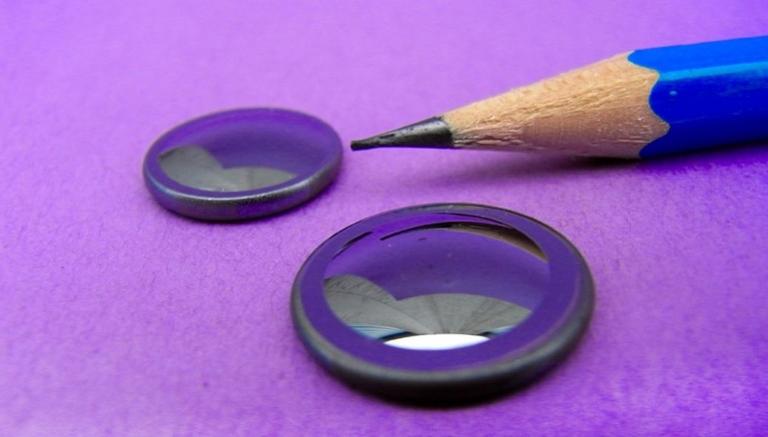 Driving at night in bad weather, or in the dark, or both can be a dangerous thing. But there's good news ahead for drivers everywhere. A group of German researchers has created a production process that may significantly cut the cost for forward looking infrared (FLIR) lenses for use in cars. FLIR can make driving at night safer, but the cost has been an enormous barrier. So, the technology remains an aftermarket add-on to a few luxury vehicles. Thanks to the work of researchers at the Fraunhofer Institute of Mechanics and Materials (IWM) in Freiburg, the prohibitive price may soon be greatly reduced. Their experimental production process could cut costs by as much as 70 percent. At present, infrared lenses are made from crystalline materials such as germanium, zinc selenide or zinc sulfide. These raw products are expensive, as is the grinding and polishing required to finish them. The IWM process replaces the crystalline materials with amorphous chalcogenide glass, which is created using sulfur, selenium or tellurium, all of which are cheaper to purchase and process, and don't need to be polished or ground. The next phase of research is to adapt the process for mass production. The technology has wide potential. Beyond driving, FLIR systems could make their way into our day-to-day lives with monitoring devices to assist the elderly, temperature monitoring in manufacturing and improving energy conservation in buildings.
Driving at night in bad weather, or in the dark, or both can be a dangerous thing. But there's good news ahead for drivers everywhere. A group of German researchers has created a production process that may significantly cut the cost for forward looking infrared (FLIR) lenses for use in cars. FLIR can make driving at night safer, but the cost has been an enormous barrier. So, the technology remains an aftermarket add-on to a few luxury vehicles. Thanks to the work of researchers at the Fraunhofer Institute of Mechanics and Materials (IWM) in Freiburg, the prohibitive price may soon be greatly reduced. Their experimental production process could cut costs by as much as 70 percent. At present, infrared lenses are made from crystalline materials such as germanium, zinc selenide or zinc sulfide. These raw products are expensive, as is the grinding and polishing required to finish them. The IWM process replaces the crystalline materials with amorphous chalcogenide glass, which is created using sulfur, selenium or tellurium, all of which are cheaper to purchase and process, and don't need to be polished or ground. The next phase of research is to adapt the process for mass production. The technology has wide potential. Beyond driving, FLIR systems could make their way into our day-to-day lives with monitoring devices to assist the elderly, temperature monitoring in manufacturing and improving energy conservation in buildings. New Infrared Lenses Could Make Driving Safer
 Driving at night in bad weather, or in the dark, or both can be a dangerous thing. But there's good news ahead for drivers everywhere. A group of German researchers has created a production process that may significantly cut the cost for forward looking infrared (FLIR) lenses for use in cars. FLIR can make driving at night safer, but the cost has been an enormous barrier. So, the technology remains an aftermarket add-on to a few luxury vehicles. Thanks to the work of researchers at the Fraunhofer Institute of Mechanics and Materials (IWM) in Freiburg, the prohibitive price may soon be greatly reduced. Their experimental production process could cut costs by as much as 70 percent. At present, infrared lenses are made from crystalline materials such as germanium, zinc selenide or zinc sulfide. These raw products are expensive, as is the grinding and polishing required to finish them. The IWM process replaces the crystalline materials with amorphous chalcogenide glass, which is created using sulfur, selenium or tellurium, all of which are cheaper to purchase and process, and don't need to be polished or ground. The next phase of research is to adapt the process for mass production. The technology has wide potential. Beyond driving, FLIR systems could make their way into our day-to-day lives with monitoring devices to assist the elderly, temperature monitoring in manufacturing and improving energy conservation in buildings.
Driving at night in bad weather, or in the dark, or both can be a dangerous thing. But there's good news ahead for drivers everywhere. A group of German researchers has created a production process that may significantly cut the cost for forward looking infrared (FLIR) lenses for use in cars. FLIR can make driving at night safer, but the cost has been an enormous barrier. So, the technology remains an aftermarket add-on to a few luxury vehicles. Thanks to the work of researchers at the Fraunhofer Institute of Mechanics and Materials (IWM) in Freiburg, the prohibitive price may soon be greatly reduced. Their experimental production process could cut costs by as much as 70 percent. At present, infrared lenses are made from crystalline materials such as germanium, zinc selenide or zinc sulfide. These raw products are expensive, as is the grinding and polishing required to finish them. The IWM process replaces the crystalline materials with amorphous chalcogenide glass, which is created using sulfur, selenium or tellurium, all of which are cheaper to purchase and process, and don't need to be polished or ground. The next phase of research is to adapt the process for mass production. The technology has wide potential. Beyond driving, FLIR systems could make their way into our day-to-day lives with monitoring devices to assist the elderly, temperature monitoring in manufacturing and improving energy conservation in buildings. 


